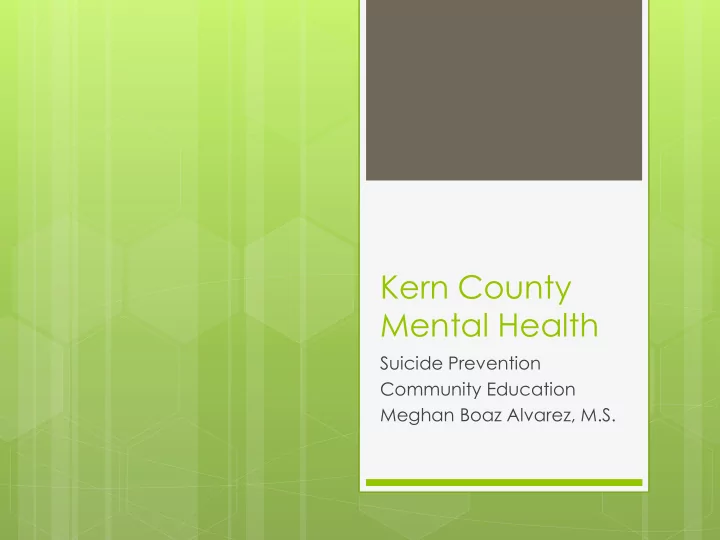

Kern County Mental Health Suicide Prevention Community Education Meghan Boaz Alvarez, M.S.
Project Goals Increase the number of people in our community who are aware of: Warning signs of suicide How to intervene to help a person at risk What local resources can help and how to access them Boost Hotline Volunteer recruitment
Community Education Tools QPR: Question, Persuade, & Refer 90 Minute gatekeeper Training We had 6 instructors take the self-study certification course (on own timeline) Liked that this could be done in 90 minutes (a good fit for a regular class) Relatively inexpensive: $500 per instructor
ASIST Applied Suicide Intervention Skills Training Two-day workshop teaching SIM with hands- on practice Agency already had a group of trainers with a monthly schedule Added 2 more through CalMHSA funded T4Ts Felt having this level of knowledge really benefitted students going in to field of mental health (target group)
Community Education Tools QPR
Implementation Barriers Very few responses to cold email blast to professors/instructors at our local campuses Almost no one was able/willing to pay for either training In the settings we were invited to, we frequently got only 15 minutes to present (too short for either training)
Implementation Facilitators Work with any timeslot you’re given 5 minutes: Cover Crisis Hotline and the Know the Signs website 15 minutes: the above and brief talk on warning signs a local resources 90 minutes: QPR Two days: ASIST
Facilitators Continued Brief presentations often led to additional opportunities to train staff & students Students who heard 5 or 15 minute talk later contacted us and came to QPR or ASIST (sometimes months later) Foot in the door technique Once people heard what was available, we had more participants for both trainings
Impact CSUB Peer counselors took QPR CSUB Resident Hall Advisors took QPR Several CSUB school counseling students came to ASIST and to our Regional Meeting Everyone who heard us present received at a minimum the information about the KCMH Hotline & local MH resources Increase in Hotline volunteer numbers from 12 to 26 in the past 18 months (most are CSUB students)
Recommendations Always say “yes” to a speaking opportunity, regardless of time allotment Time invested here will lead to further opportunities and greater numbers of people educated/trained (school example: 120) Cover costs of training when possible (everyone likes a freebie!) Have several levels of presentation available so that requests can be met without having to customize each time Partner with other organizations that have trainers or speakers (CSUB partnership)
Sustainability Partnering with other local agencies to share cost May have to charge a fee, but possibly materials only fee Select trainings/programs that do not have a regular renewal fee Create your own educational program/presentation (we do this anyway…SOT example)
Meghan Boaz Alvarez, M.S., MFT Kern County Mental Health Crisis Hotline & Access Center mboaz@co.kern.ca.us 661.868.8007
Recommend
More recommend